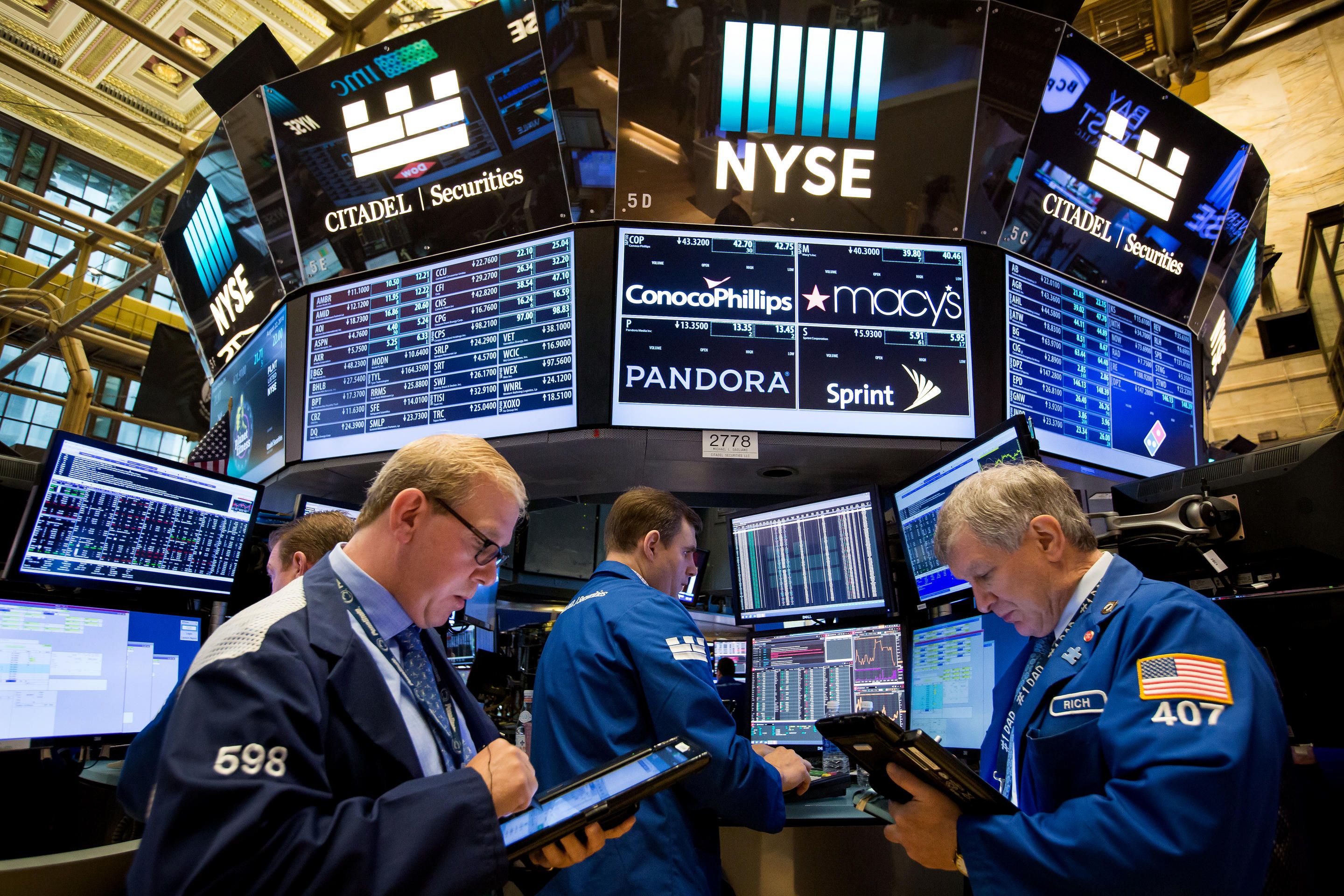Economy
Traders May Stick to Sidelines After Last Week’s Sell-Off

By Investors Hub
The major U.S. index futures are pointing to a roughly flat open on Monday following the sell-off seen on Wall Street last week.
Traders may look to pick up stocks at reduced levels, although concerns about the global economic outlook and skepticism about the potential for a long-term trade deal between the U.S. and China is likely to sap investors risk appetite.
Overall trading activity may be somewhat subdued, with a lack of major U.S. economic data likely to keep some traders on the sidelines.
The economic calendar remains relatively light throughout the week, although reports on producer and consumer price inflation, retail sales, and industrial production are likely to attract attention.
Traders may nonetheless remain reluctant to make significant moves ahead of the Federal Reserve?s monetary policy meeting next week.
With the Fed widely expected to raise interest rates by another quarter point, traders will closely scrutinize the accompanying statement for clues about future rate hikes.
Traders may look to pick up stocks at reduced levels on the heels of last week?s sell-off, which came amid skepticism about the potential for a long-term trade deal between the U.S. and China.
Overall trading activity may be somewhat subdued, however, with a lack of major U.S. economic data likely to keep some traders on the sidelines.
The economic calendar remains relatively light throughout the week, although reports on producer and consumer price inflation, retail sales, and industrial production are likely to attract attention.
Traders may nonetheless be reluctant to make significant moves ahead of the Federal Reserve?s monetary policy meeting next week.
With the Fed widely expected to raise interest rates by another quarter point, traders will closely scrutinize the accompanying statement for clues about future rate hikes.
After fluctuating early in the session, stocks moved sharply lower over the course of the trading day on Friday. The major averages showed a substantial move back to the downside following the rebound from early weakness seen on Thursday.
The major averages climbed off their worst levels going into the close but remained firmly negative. The Dow tumbled 558.72 points or 2.2 percent to 24,388.95, the Nasdaq plunged 219.01 points or 3.1 percent to 6,969.25 and the S&P 500 slumped 62.87 points or 2.3 percent to 2,633.08.
With the steep drop on the day, the major averages moved significantly lower for the week. The Nasdaq nosedived by 4.9 percent, while the Dow and the S&P 500 plummeted by 4.5 percent and 4.6 percent, respectively.
The sell-off on Wall Street came after the Labor Department’s closely watched monthly jobs report showed U.S. employment increased by much less than expected in the month of November.
The Labor Department said non-farm payroll employment rose by 155,000 jobs in November after surging up by a downwardly revised 237,000 jobs in October.
Economists had expected employment to climb by about 200,000 jobs compared to the jump of 250,000 jobs originally reported for the previous month.
Meanwhile, the report said the unemployment rate in November remained unchanged for the second straight month at 3.7 percent, holding at its lowest level since hitting 3.5 percent in December of 1969.
Average hourly employee earnings rose by $0.06 to $27.35 in November, reflecting a 3.1 percent increase compared to the same month a year ago. The annual rate of growth was unchanged from October.
“The slightly more modest 155,000 gain in payroll employment in November may not go down well in markets given the heightened nervousness in recent months,” said Paul Ashworth, Chief U.S. Economist at Capital Economics.
“But this is still a solid gain that suggests economic growth is gradually slowing back towards its potential pace,” he added. “There is nothing here to suggest the economy is suffering a more sudden downturn.”
Lingering skepticism about a U.S.-China trade agreement also weighed on the markets even though President Donald Trump tweeted, “China talks are going very well!”
Most of the major sectors showed notable moves to the downside over the course of the session, reflecting a broad based sell-off on Wall Street.
Computer hardware stocks showed a particularly steep drop on the day, dragging the NYSE Arca Computer Hardware Index down by 4.1 percent to a nearly two-year closing low.
Tech giant IBM Corp. (IBM) posted a significant loss after agreeing to sell some of its software products to India-based HCL Technologies for $1.8 billion.
Substantial weakness was also visible among transportation stocks, as reflected by the 3.9 percent nosedive by the Dow Jones Transpiration Average. The average tumbled to its lowest closing level in well over a month.
Semiconductor, software,
biotechnology, and retail stocks also saw considerable weakness, while
gold stocks were among the few groups to buck the downtrend amid an
increase by the price of the precious metal.
Economy
FAAC Disburses 1.727trn to FG, States Local Councils in December 2024

By Modupe Gbadeyanka
The federal government, the 36 states of the federation and the 774 local government areas have received N1.727 trillion from the Federal Accounts Allocation Committee (FAAC) for December 2024.
The funds were disbursed to the three tiers of government from the revenue generated by the nation in November 2024.
At the December meeting of FAAC held in Abuja, it was stated that the amount distributed comprised distributable statutory revenue of N455.354 billion, distributable Value Added Tax (VAT) revenue of N585.700 billion, Electronic Money Transfer Levy (EMTL) revenue of N15.046 billion and Exchange Difference revenue of N671.392 billion.
According to a statement signed on Friday by the Director of Press and Public Relations for FAAC, Mr Bawa Mokwa, the money generated last month was about N3.143 trillion, with N103.307 billion used for cost of collection and N1.312 trillion for transfers, interventions and refunds.
It was disclosed that gross statutory revenue of N1.827 trillion was received compared with the N1.336 trillion recorded a month earlier.
The statement said gross revenue of N628.972 billion was available from VAT versus N668.291 billion in the preceding month.
The organisation stated that last month, oil and gas royalty and CET levies recorded significant increases, while excise duty, VAT, import duty, Petroleum Profit Tax (PPT), Companies Income Tax (CIT) and EMTL decreased considerably.
As for the sharing, FAAC disclosed that from the N1.727 trillion, the central government got N581.856 billion, the states received N549.792 billion, the councils took N402.553 billion, while the benefiting states got N193.291 billion as 13 per cent derivation revenue.
From the N585.700 billion VAT earnings, the national government got N87.855 billion, the states received N292.850 billion and the local councils were given N204.995 billion.
Also, from the N455.354 billion distributable statutory revenue, the federal government was given N175.690 billion, the states got N89.113 billion, the local governments had N68.702 billion, and the benefiting states received N121.849 billion as 13 per cent derivation revenue.
In addition, from the N15.046 billion EMTL revenue, FAAC shared N2.257 billion to the federal government, disbursed N7.523 billion to the states and transferred N5.266 billion to the local councils.
Further, from the N671.392 billion Exchange Difference earnings, it gave central government N316.054 billion, the states N160.306 billion, the local government areas N123.590 billion, and the oil-producing states N71.442 billion as 13 per cent derivation revenue.
Economy
Okitipupa Plc, Two Others Lift Unlisted Securities Market by 0.65%

By Adedapo Adesanya
The NASD Over-the-Counter (OTC) Securities Exchange recorded a 0.65 per cent gain on Friday, December 13, boosted by three equities admitted on the trading platform.
On the last trading session of the week, Okitipupa Plc appreciated by N2.70 to settle at N29.74 per share versus Thursday’s closing price of N27.04 per share, FrieslandCampina Wamco Nigeria Plc added N2.49 to end the session at N42.85 per unit compared with the previous day’s N40.36 per unit, and Afriland Properties Plc gained 50 Kobo to close at N16.30 per share, in contrast to the preceding session’s N15.80 per share.
Consequently, the market capitalisation added N6.89 billion to settle at N1.062 trillion compared with the preceding day’s N1.055 trillion and the NASD Unlisted Security Index (NSI) gained 19.66 points to wrap the session at 3,032.16 points compared with 3,012.50 points recorded in the previous session.
Yesterday, the volume of securities traded by investors increased by 171.6 per cent to 1.2 million units from the 447,905 units recorded a day earlier, but the value of shares traded by the market participants declined by 19.3 per cent to N2.4 million from the N3.02 million achieved a day earlier, and the number of deals went down by 14.3 per cent to 18 deals from 21 deals.
At the close of business, Geo-Fluids Plc was the most active stock by volume on a year-to-date basis with a turnover of 1.7 billion units worth N3.9 billion, followed by Okitipupa Plc with the sale of 752.2 million units valued at N7.8 billion, and Afriland Properties Plc with 297.3 million units sold for N5.3 million.
In the same vein, Aradel Holdings Plc remained the most active stock by value on a year-to-date basis with the sale of 108.7 million units for N89.2 billion, trailed by Okitipupa Plc with 752.2 million units valued at N7.8 billion, and Afriland Properties Plc with a turnover of 297.3 million units worth N5.3 billion.
Economy
Naira Trades N1,533/$1 at Official Market, N1,650/$1 at Parallel Market

By Adedapo Adesanya
The Naira appreciated further against the United States Dollar at the Nigerian Autonomous Foreign Exchange Market (NAFEM) by N1.50 or 0.09 per cent to close at N1,533.00/$1 on Friday, December 13 versus the N1,534.50/$1 it was transacted on Thursday.
The local currency has continued to benefit from the Electronic Foreign Exchange Matching System (EFEMS) introduced by the Central Bank of Nigeria (CBN) this month.
The implementation of the forex system comes with diverse implications for all segments of the financial markets that deal with FX, including the rebound in the value of the Naira across markets.
The system instantly reflects data on all FX transactions conducted in the interbank market and approved by the CBN.
Market analysts say the publication of real-time prices and buy-sell orders data from this system has lent support to the Naira in the official market and tackled speculation.
In the official market yesterday, the domestic currency improved its value against the Pound Sterling by N12.58 to wrap the session at N1,942.19/£1 compared with the previous day’s N1,954.77/£1 and against the Euro, it gained N2.44 to close at N1,612.85/€1 versus Thursday’s closing price of N1,610.41/€1.
At the black market, the Nigerian Naira appreciated against the greenback on Friday by N30 to sell for N1,650/$1 compared with the preceding session’s value of N1,680/$1.
Meanwhile, the cryptocurrency market was largely positive as investors banked on recent signals, including fresh support from US President-elect, Mr Donald Trump, as well as interest rate cuts by the European Central Bank (ECB).
Ripple (XRP) added 7.3 per cent to sell at $2.49, Binance Coin (BNB) rose by 3.5 per cent to $728.28, Cardano (ADA) expanded by 2.4 per cent to trade at $1.11, Litecoin (LTC) increased by 2.3 per cent to $122.56, Bitcoin (BTC) gained 1.9 per cent to settle at $101,766.17, Dogecoin (DOGE) jumped by 1.2 per cent to $0.4064, Solana (SOL) soared by 0.7 per cent to $226.15 and Ethereum (ETH) advanced by 0.6 per cent to $3,925.35, while the US Dollar Tether (USDT) and the US Dollar Coin (USDC) remained unchanged at $1.00 each.
-

 Feature/OPED5 years ago
Feature/OPED5 years agoDavos was Different this year
-
Travel/Tourism8 years ago
Lagos Seals Western Lodge Hotel In Ikorodu
-

 Showbiz2 years ago
Showbiz2 years agoEstranged Lover Releases Videos of Empress Njamah Bathing
-

 Banking6 years ago
Banking6 years agoSort Codes of GTBank Branches in Nigeria
-

 Economy2 years ago
Economy2 years agoSubsidy Removal: CNG at N130 Per Litre Cheaper Than Petrol—IPMAN
-

 Banking2 years ago
Banking2 years agoFirst Bank Announces Planned Downtime
-

 Sports2 years ago
Sports2 years agoHighest Paid Nigerian Footballer – How Much Do Nigerian Footballers Earn
-

 Technology4 years ago
Technology4 years agoHow To Link Your MTN, Airtel, Glo, 9mobile Lines to NIN











